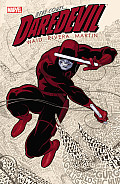Mark Waid and the Evolution in Digital Comics
Mark Waid is one of the best superhero comics scripters around, and has created interesting comics in other genres as well. As a hungry freelancer and occasional editor, he’s very concerned about how digitization is affecting that storytelling form.
Two years ago Waid gave a speech at the Harvey Awards about file-sharing’s effect on the comics business that went over so badly he felt a need to rearrange his notes into an essay on Comic Book Resources. It called for innovation, concluding:
A few months later Waid went into greater length about copyrights and digital comics in a long interview after leaving BOOM! Studios to become a freelancer once again. And late last month Waid previewed a new format for digital comics with this short demo film.
Currently digital adaptations of printed comics struggle to adapt art created for the aspect ratio of a magazine page to the various screen sizes of our devices. The most popular software, such as that from ComiXology, can offer a full-page view (readable only on iPads and similar large tablets, and sometimes not even then), but their main format involves showing each panel or part of a panel in sequence. This can be awkward.
Waid and his artists started with a smartphone screen, using a horizontal aspect ratio, as their basic page or canvas. A space that size can show one to three panels at a time. A “swipe” or tap can bring on the next set of panels, like a traditional page turn, or add elements to the current page, including:
Two years ago Waid gave a speech at the Harvey Awards about file-sharing’s effect on the comics business that went over so badly he felt a need to rearrange his notes into an essay on Comic Book Resources. It called for innovation, concluding:
We are the smartest, most creative medium in America. We put out ideas on a periodical basis bam, bam, bam. We don’t put out a screenplay every three years. We don’t invent a TV show every ten years. There are more ideas in one Wednesday in one comic shop than in three years of Hollywood. We’re notoriously bad businessmen, but we are unmatched for creativity and inventiveness, and there are ways to make filesharing work for us rather than cower in fear that it’s going to destroy us.Of course, the sort of creativity that involves ray guns and retroactive continuity is different from the sort that comes up with successful new business models.
A few months later Waid went into greater length about copyrights and digital comics in a long interview after leaving BOOM! Studios to become a freelancer once again. And late last month Waid previewed a new format for digital comics with this short demo film.
Currently digital adaptations of printed comics struggle to adapt art created for the aspect ratio of a magazine page to the various screen sizes of our devices. The most popular software, such as that from ComiXology, can offer a full-page view (readable only on iPads and similar large tablets, and sometimes not even then), but their main format involves showing each panel or part of a panel in sequence. This can be awkward.
Waid and his artists started with a smartphone screen, using a horizontal aspect ratio, as their basic page or canvas. A space that size can show one to three panels at a time. A “swipe” or tap can bring on the next set of panels, like a traditional page turn, or add elements to the current page, including:
- an additional panel, not shown to readers before.
- more of a panel image, which can produce the effect of a camera pulling back.
- new details within a panel image, which produces the effect of time passing.
- changing “showing the invisible” elements of the comics form, such as a caption or word balloon.



No comments:
Post a Comment